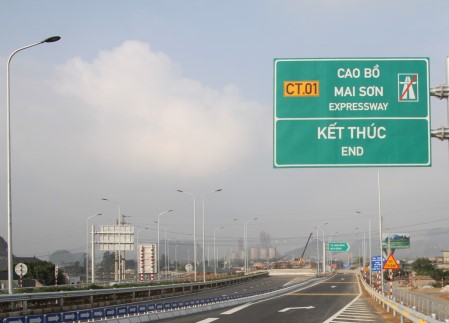 Society
Society

 |
| NA deputy Phan Viết Lượng. — VNA/VNS Photo Văn Điệp |
On May 22, at the seventh session of the 15th National Assembly, plans were put up for investment in the construction of the Gia Nghĩa (Đắk Nông) - Chơn Thành (Bình Phước) section of the North-South Western Expressway, with a total cost of approximately VNĐ25.540 trillion (US$1 billion), including State and private funds.
Vietnam News Agency reporter spoke with NA deputy Phan Viết Lượng from Bình Phước about the future of the project.
The Gia Nghĩa – Chơn Thành expressway is part of the North-South Western Expressway and is an important traffic axis connecting the Central Highlands with the southeast region. How significant is this project?
The national expressway network will include 41 routes with a total length of more than 9,000km. To date, about 2,000km have been put into operation, 1,681km is under construction, and approximately 805km is being prepared for investment. The eastern part of the North-South Expressway will basically be completed by 2025.
The Gia Nghĩa – Chơn Thành expressway, however, is the western part of the North-South Expressway. This is an important traffic axis connecting the Central Highlands with the southeast and southwestern regions. Investing in the Gia Nghĩa – Chơn Thành expressway will solve the traffic infrastructure bottlenecks and drive the socio-economic development of this area.
The project will open up new development space and enhance regional and inter-regional connectivity, especially connections to Long Thành International Airport and Cái Mép - Thị Vải Port, serving the socio-economic development of the Central Highlands and southeast regions and strengthening national defence and security.
In addition to socio-economic development, the Central Highlands is key to national defence and security. If invested in, it will clearly create driving forces to promote and leverage the region's potential and advantages, boost socio-economic development and ensure national defence and security. Therefore, localities in the project area are very supportive.
The Government proposes investing in the project through a public-private partnership (PPP). However, attracting investors and financial institutions to participate in these kind of projects has been challenging. How can feasibility of the project be ensured?
Localities have been very proactive in coordinating with ministries and sectors, consulting and discussing extensively with investors to clarify data and have a basis for project development. Making the project attractive to investors or changing the investment ratio between the State and private investors was a question raised from the outset.
Previously, for some sections of the Eastern Expressway, the National Assembly decided but later had to adjust the PPP investment plan. These are valuable experiences for developing the investment plan for this project.
Specifically, we must increase the State investment in the PPP plan, carefully assess and develop a feasibility report, particularly with clear financial plans. The impact of projects in the system must also be considered, with traffic volumes and related costs on the repayment and recovery capabilities of private investors.
Both central and local authorities must recognise their responsibilities, with the Government as well as ministries of Transport, Planning and Investment, Finance and Construction involved from the beginning of the project. From there, there is a common voice in assessing the project's feasibility.
In terms of Bình Phước Province, despite certain difficulties, based on recent increased budget revenues, it is still committed to accompanying investors later, even participating with local funds.
Special attention is given to surveying the site, developing resettlement plans to facilitate and shorten construction time. Each unit must have its financial plan to ensure the project's feasibility regarding the implementation timeline. The project's feasibility is optimistic due to lessons learned.
What are your expectations for the transportation connectivity of the project for this region?
Currently, the quantity and quality of expressways in the southeast region, especially passing through Bình Phước, are very few and if you travel from Đồng Xoài (Bình Phước) to Đắk Nông it might take you more than three hours.
However, once completed, the project will reduce travel time by a third. Moreover, this route connects Bình Phước with many locations, creating significant opportunities and momentum for socio-economic development.
When this road is completed, transportation will be more convenient; simultaneously, some routes from Bình Phước, Bình Dương to HCM City will continue to expand. Connections from this project will create momentum and open up plans for subsequent projects from Bình Phước to Đồng Nai, Long Thành Airport, or Tây Ninh.
Voters in provinces with expressway projects are always supportive and have high expectations. As a result, localities participate from the beginning and mobilise support among locals, facilitating the central Government's decision-making process.
Moreover, there is a high determination from central to local authorities in cautiously preparing and being ready to implement the resolution once approved by the National Assembly.
The project volume is large, while the timeframe is limited. Will this affect the feasibility of implementation if the project is approved? Have land clearance and local material sources been prepared?
The project has been divided into investment phases with five sub-projects, including an independent land clearance project. The locality considers this project very important and cannot let it affect the progress or attractiveness to investors.
By separating it like this, the responsibilities of the locality are clear, allowing for proactive and creative land clearance. The advantage is that now, the National Assembly's review and decision are later than initially expected. However, this delay allows the locality more time to complete thorough site surveys and assessments.
Regarding sourcing material, this region differs from the Mekong Delta, so construction will be easier. — VNS




